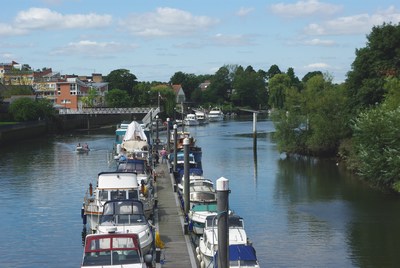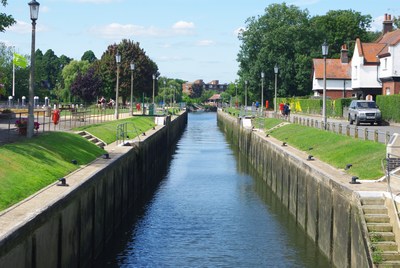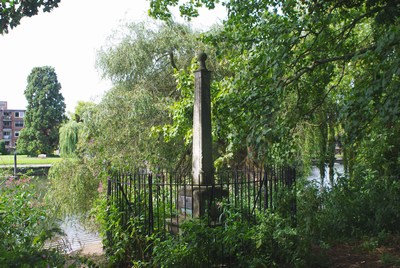Teddington Lock
I am approaching a very significant marker on the walk. This is the end of the non-tidal river. In medieval times the tidal reaches were reckoned to extend as far upstream as Staines, but with the addition of locks the tidal effect now stops at Teddington Lock.
 Boats at Teddington Lock
Boats at Teddington Lock
To be precise Teddington should be referred to in the plural, for there are three locks at this location, the Launch Lock, the Barge Lock and the Skiff lock. The three locks make up by far the biggest lock system along the whole of the river.
As I walk towards the locks I can see them laid out before me. The massive Barge Lock 650 feet long was designed to take a steam tug plus six barges and was completed in 1905. The smaller Launch Lock is 178 feet long and was built in 1858. Both of these locks completely dwarf the Skiff Lock, which at a mere 50 feet in length is also known as the “Coffin Lock”, presumably an allusion to the claustrophobic feeling that one must have if you are at the bottom of it.
 Teddington Skiff Lock
Teddington Skiff Lock
I have to make a decision here because there is a choice for the next two days. The Thames Path splits into two, one following the North Bank and the other the South Bank. I have chosen the South Bank mainly because it appeared to offer more variety, and also because it finished at the Barrier Visitor Centre.
 Thames Conservancy Marker
Thames Conservancy Marker
Only a couple of hundred yards below the locks I pass an obelisk. This stone was erected in 1909 and marks the old boundary between the jurisdictions of the Thames Conservancy and the Port of London Authority. It is a significant marker on my journey that brings the thought that I am now on the final count-down to journey’s end.
< Previous Page | Next Page >